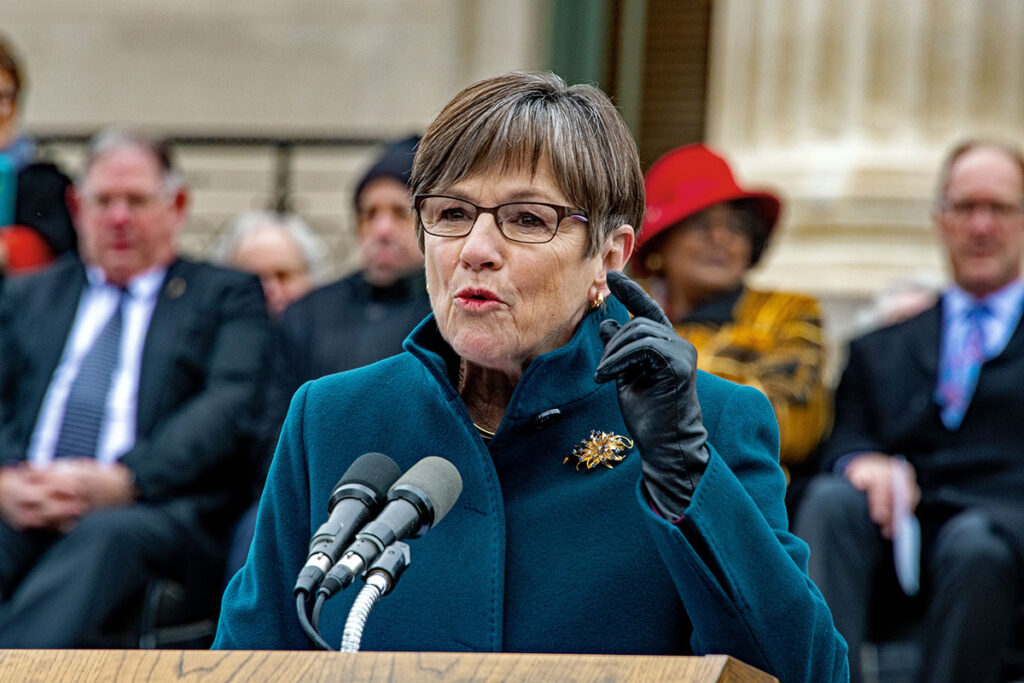Kansas Governor Laura Kelly gave her 2022 State of the State address this week to mark the beginning of this year’s legislative session. This speech, set against a backdrop of the ever-growing state revenue surplus, included many of the Governor’s already announced ideas and plans for what to do with the cash.
In the speech, Governor Kelly cites “30,000 new jobs. That’s 30,000 even during a pandemic.” This isn’t fully accurate though. Kansas is still recovering jobs it lost at the onset of the COVID-19 pandemic in 2020, not creating new ones. According to the most recent November jobs numbers, Kansas is still 27,000 jobs below its January 2020 levels, and at the current job growth rate, isn’t set to recover until around August of 2022. Last month as well, 6,290 left the labor force as a whole compared to the gain of 2,400 jobs. It’s obvious that staggering job losses happened in 2020 through no government action but don’t tell Kansans that a lagging recovery is evidence of a booming economy.
Another of Kelly’s claims was about “$3.8 billion” in investment across the state. The part that’s missing here is that much of this “investment” is from taxpayer subsidies. For instance, Kelly cites the Schwan Pizza plant in Salina as a sign of investment but leaves out the part where the plant is financed by $600 million in industrial revenue bonds coming from taxpayers’ wallets. Subsidies like STAR Bonds and PEAK bonds make taxpayers foot the bill for corporate expansion while oftentimes not bringing about economic change that wouldn’t have happened anyways.
In a 2020 KPI report analyzing STAR Bonds in Wichita, the subsidies “had no measurable effect on the persistent decline of business and job growth in downtown Wichita” and the STAR bond-funded Greenwich project experienced growth that “would have happened anyway” if not through them. A 2017 analysis by Nathan Jensen with the Kauffman Foundation found that there was little evidence that Kansas bond recipients experienced a significant boost and employment compared to non-peak recipients. Jensen recently reported that 75% of companies awarded incentives in the Kansas City area would have made “similar investment regardless of the public subsidy.”
Two of Governor Kelly’s other points in the speech were reiterating her intent to give a $250 rebate to 2021 tax filers as well as eliminating the sales tax on groceries. These policies take advantage of the projected $2.9 billion tax revenue surplus the state is expected to take in by the end of its fiscal year in July.
Both these ideas need less election-year rhetoric and more long-term relief and fiscal stability. Instead of a one-year rebate, a married couple could save $500 every year with small rate reductions in their income taxes. Reducing marginal rates, in the long run, could be an effective tool in bringing in more people and businesses to Kansas, which currently ranks middle-of-the-pack in competitiveness. As recent Census results demonstrate, six of the ten highest gaining states for domestic migration over the past year were states in the Top 10 for least burdensome taxes.
Similarly, Kelly’s food tax proposal comes with a $450 million price tag annually. Seeing as how large budget surpluses in the early 2010s motivated large tax cuts without a decrease in spending (in fact, the opposite happened), it would be best to not avoid a similar outcome and plan on reducing spending in the long run to match the reduced revenue.
Immediate savings can be found by deep dives into discretionary spending. Audits on expenditures should be subject to yearly analysis to determine if they are a meaningful contribution to state endeavors. Not replacing employees who retire or otherwise leave also has big potential. Kansas state and local governments have about 37% more employees per capita than the national average; right-sizing local government employment can save up to $2 billion. Counties whose populations were between 6,000 to 10,000 people in 2018 varied in their per-resident spending from a high of $3,038.58 to a low of $949.97 with an average of around $1,402.61 – there’s room across the state to see what is effective usage of taxpayer dollars and to trim that down.
Governor Kelly also made a deposit of $600 million into the state’s Rainy Day Fund (RDF). Seeing as how previously this fund has been sitting empty and is ranked dead last in the country in RDF health according to the Tax Foundation. If this change goes through, then the RDF would contain 7.25% of Kansas’ FY 2022 Approved General Fund Budget, which would shoot the state up to #31 in RDF health assuming no changes in other states since 2020.
With Kelly’s speech also came a released Governor’s Budget, which deserves its own analysis. But for now, legislators need to remember that Kansas has many opportunities for growth by honestly addressing taxation and spending issues that currently slow it.





